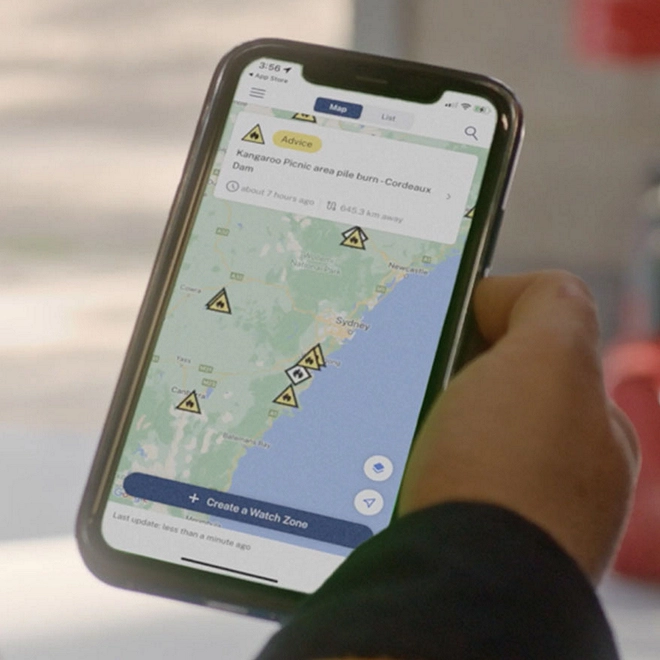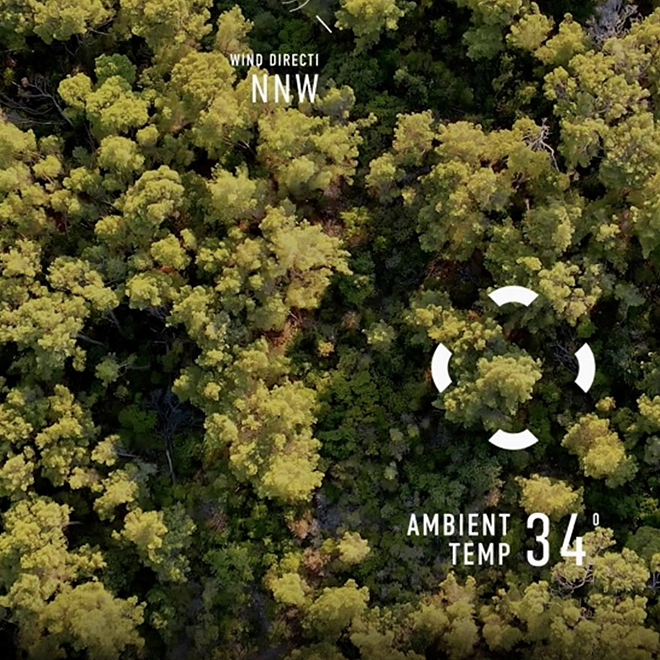The future of fire
How technology can evolve climate-related disaster response

The climate crisis is changing our bushfire landscape. Extreme fire seasons are more common, and the fires larger and harder to control. The emergence of megafires is a clear indication of the escalating threat we face, as demonstrated by recent events in Canada and the West Coast of the United States.
Deloitte estimates natural disasters currently cost the economy $38 billion per year, a figure we predict will increase to $73 billion per year by 2060. Even if net zero is achieved - whereby timely action will see net emissions start to fall and reach zero by 2100 - the cumulative cost of natural disasters may be $1.2 trillion over the next forty years1. The phenomenal impact of Australian bushfires will escalate. As they destroy carbon-sequestering forests, megatons of carbon dioxide pour into the atmosphere, accelerating the climate change that increases the risk.
Jill Riseley, a Partner in Deloitte’s Climate and Engineering team comments “In the developed world, Australia is one of the countries most vulnerable to climate change impacts and our unique biodiversity is particularly at risk. In fact, the 'lucky country' will face unique challenges in the decades ahead with each major city susceptible to extreme heat, rain and flooding in some areas. We have all witnessed the devastating impacts of natural disasters such as bushfires. As a nation, the cost of inaction on climate change will be much higher than the costs of acting. Critical to ensuring resilience and responsiveness to a changing climate will be the level of organisational and government preparedness”.
New technologies are already in play to manage disasters worldwide. However, as the magnitude and duration of devastation continues to evolve, it is evident that more needs to be done; the way we manage preparation, response and recovery must also undergo significant changes to effectively address these challenges.
CAL FIRE using predictive technologies to outflank fires
In July 2020, the California Department of Forestry and Fire Protection signed a 3-year contract with Technosylva to deploy an advanced wildfire risk forecasting product. Wildfire Analyst Enterprise integrates weather predictions, on-demand fire spread predictions and fire behaviour analysis to support setting readiness levels, resource prioritisation and operational response, as well as machine learning to make predictions on fire behaviour. The tool predicted the CZU Lightning Complex fire, which burned more than 86,000 acres, saving a number of houses.
Machine learning, AI and data modelling will support human decision making
Bushfires are fundamentally different from building fires – the goal isn’t to put out the fire but to manage the boundary, using available information to decide where resources are needed and how the fire might behave. By adopting this approach, communities, properties, land, and wildlife can be effectively safeguarded, thereby enhancing overall protection.
Response teams are generally able to respond according to their practiced procedures throughout the year. However, preparing for catastrophic megafires is extremely challenging. Only a small number, if any, of those who fought the 2019/2020 bushfires had encountered a disaster of that magnitude before.
Already we’re seeing systems draw on various sources, from weather via the Bureau of Meteorology (BOM), to systems for vegetation coverage. Overlaying large datasets, and applying complex modelling and AI, can help determine the probability of certain scenarios. With this incredible volume of data, systems will be able to assess and analyse a constantly changing situation.
Future AI, machine learning and data modelling will be designed for unprecedented crises, supporting teams to operate well outside business as usual. Simultaneously modelling – and thus predicting – all possible outcomes is beyond human capability, but computational advancements will free up expertise to make decisions at speed.
Dr Kellie Nuttall, Partner, AI Institute at Deloitte advises that “AI in Australia's bushfire battle isn't just technology—it's a lifesaver. AI technologies arm us with the power to predict the unpredictable, enabling rapid, informed decision-making that can save lives and preserve our environment”
This large-scale potential of AI is also starting to be explored by Governments and other public sector entities. Key policymakers are reimagining the role of technology to help solve some of humanity’s most complex problems and address citizens’ growing demand for real-time, digital interactions with public services. Deloitte AI experts stating, “The pace is fast; decisions will likely have to be made and Artificial Intelligence can play a crucial role in this effort. By automating routine tasks, analysing data and predicting outcomes, AI can help the next generation of governments to make better, more agile and efficient decisions”

Omnichannel communication will create better real-time disaster response
The AI that transforms decision making will also collect, process and analyse multichannel data for richer modelling, better predictions and decisions that save lives.
In an emergency, people on the ground are a wealth of potential information – from what they can see and hear, to where they are and how fires are moving. Historically, emergency response communication has been one-way, disseminating information to the at-risk public without collecting data in response. Vital information like photos, video, voice and location data – information that could be critical to fire management decisions – is missed.
We’ll see emergency services start to use this data. As well as helping with fire response, it will inform the public in a more meaningful way. In future, we will create calls to action that work alongside fire danger ratings, giving residents actionable advice to stay safe.
In response to people's desire for real-time information on their own terms and devices, communication methods will evolve. Coupling the delivery of better, richer, and more timely information with clear, reply-enabled instructions on actions to be taken, emergency response teams will simultaneously inform and gather, working with communities in two-way conversations that will ultimately save lives.
Unmanned drones will fight fires before they lose control
In California’s Menlo Park Fire District, drones are providing valuable eyes in the sky during fires, including in extreme weather conditions and at night. Silicon Valley-based Rain Industries aims to contain bushfires within 10 minutes of ignition, using autonomous drones with fire-fighting chemicals. Closer to home, Andrew Forrest, Chairman of Fortescue Metals Group, unveiled ‘Fire Shield’, aiming to use a sensors to dispatch drones that can extinguish any fire within an hour, 24/7.
Connectivity will evolve to keep vital information flowing
Australia doesn’t have an emergency services-grade mobile network. Carriers can’t guarantee response teams access to their services, while emergencies themselves increase pressure on mobile networks as people try to get help and stay in touch with each other. Emergency services do have access to the paging and government radio networks, but often with long wait times.
We’re already seeing technologies help to overcome these issues – low-orbit satellites, for example, give residents connectivity while freeing up the government radio network for where it’s really needed.
We’ll also see the continued evolution of IoT systems, which will contribute to this growing library of data, from street cameras capturing visuals of fires, to smart weather stations, through to sensors to monitor fuel conditions like soil moisture. With improved capability to send this information back across mobile networks, emergency response teams will be making decisions with a clearer picture than ever.
Using satellite data to detect fire in the world’s densest forests
South Korea has one of the world’s most densely distributed forests, with a large coniferous make-up that dries easily, meaning bushfires can quickly become severe without an immediate response. Common methods, such as threshold-based algorithms, have been prone to false alarms and missed fires. HIMAWARI-8 uses geostationary satellite data to detect and monitor forest fires, scanning a focus area about every two minutes. Among the 52 forest fires detected, 25 were detected within 10 minutes.
Government will need to coordinate across agencies
Finally, it is imperative that we witness transformative actions taking place within the realm of government. To effectively address increasingly severe and widespread incidents, it is crucial for governments and emergency services agencies to enhance their collaborative efforts on a larger scale and across various jurisdictions.
We might expect to see a more integrated set of emergency services, with the ability to better coordinate large-scale incidents across agencies like police, SES, Fire and Rescue, RFS, the National Parks Authority. True integration will even include the power companies trying to keep poles and wires functional, and telcos working to keep 4G towers going.
Pressure from society will challenge the existing models. The public already knows technology can provide this level of integration – they see it every day with Cloud apps for even the most simple tasks. Their expectation will be that Australian governments are prioritising their safety, and governments must rise to the challenge.
[1] https://www.deloitte.com/au/en/services/economics/perspectives/building-australias-natural-disaster-resilience.html
To read about the work Deloitte Australia is doing with the New South Wales Rural Fire Service, visit here.



